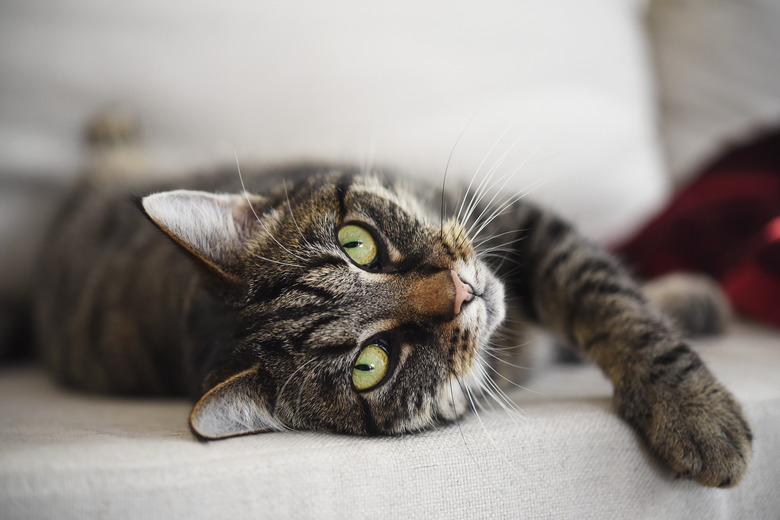Cat Chromosome Information
Each cell's nucleus contains chromosomes made up of DNA strands. They contain the genetic material that determines an organism's traits and are passed on to offspring. Cats each have a set number of chromosomes that include a pair of sex chromosomes known as X and Y. Chromosomes occur in pairs, with one of each pair coming from the mother and the other from the father. Genes at corresponding locations on each pair affect the same trait, and together determine the cat's color, fur length and other characteristics.
Number
Number
Domestic cats have 38 chromosomes, as compared to 46 in humans. The chromosomes come in 19 matched pairs, with one of each pair coming from each parent. Some species of cat such as the ocelot have only 36 chromosomes, and breeding such a cat with a cat that has 38 chromosomes will result in offspring that have 37 chromosomes. The males in the litter, however, are likely to be sterile.
Reproduction
Reproduction
When cells divide, the chromosomes are replicated via a process called mitosis. Each daughter cell gets 38 chromosomes just like the parent cell. The exception occurs during the creation of gametes: sperm and eggs. Instead of mitosis, reproductive cells use meiosis, which cuts in half, to 19, the number of chromosomes in the daughter cells. Thus when an egg is fertilized by a sperm, the two half-sets of chromosomes combine, and the resulting cells have the normal 38 chromosomes.
Types
Types
Each kitten gets two sex chromosomes, one from its mother and one from its father. If it has two X chromosomes it is a girl, and if it has an X and a Y chromosome, it is a boy. Since only boys have Y chromosomes, the mother always passes on an X chromosome to offspring, and the father's chromosome determines the kitten's gender. This is comparable to gender determination in humans. The other 18 pairs of chromosomes are known as autosomes.
Genes
Genes
Each chromosome is made up of many genes, which are portions of DNA that code for specific traits. Genes on a cat's chromosomes determine the cat's color, fur length, fur pattern and other aspects of its appearance and physiology. Due to mutations over time, a specific gene can have two or more variations, and these variations in genotype result in different traits or phenotypes. The different variations are known as alleles. In some cases one allele is dominant over the other, meaning it alone controls the trait; in other cases the two alleles in combination produce a different trait than either alone.
Effects on Fur Color
Effects on Fur Color
About 20 different genes altogether determine the color and pattern of a cat's coat. There are only two basic fur colors: black and red. These colors are produced by different pigments, and all other variations in color are variations of these two. White fur occurs in the absence of either of the pigments. One gene produces either black, brown or cinnamon fur depending on the combination of the two alleles received from the two parents. Another gene dilutes black to the gray color known as "blue" and dilutes red to cream. The agouti gene determines whether each individual hair is solid colored or varies in the amount of pigment, resulting in both darker and lighter areas on the same hair. Agouti hairs produce the appearance of tabby and ticked tabby coats.
Sex Linkage
Sex Linkage
Only a few genes are located on the Y chromosome, which only male kittens get. Most of these are responsible for male sexual development. Many more genes are on the larger X chromosome. Male kittens receive only one copy of a gene on the X chromosome from the mother, while female kittens get two copies, one from each parent. For example, the red fur gene or O gene, which results in orange or rust colored fur, is located on the X chromosome, so male kittens get only one copy of that gene. To be calico or tortoiseshell, a cat must have two copies of the O gene, and thus two X chromosomes. So all calico and tortie cats are females except for rare males with two X chromosomes and a Y chromosome.
Interactions
Interactions
Genes on one chromosome can affect or "mask" the expression of genes on another chromosome. For example, the dilute gene on one chromosome alters the fur color that would otherwise be determined by the gene on a different chromosome. The tabby gene determines the overall pattern of the fur that appears as a result of a kitten inheriting the dominant agouti gene. A cat with the agouti gene can have the common mackerel tabby pattern, the striking classic tabby pattern, or in some species, such as the Abyssinian, a ticked tabby pattern.
Cite This Article
MLA
Wiesenfelder, Heidi. "Cat Chromosome Information" sciencing.com, https://www.sciencing.com/cat-chromosome-information-5431730/. 13 March 2018.
APA
Wiesenfelder, Heidi. (2018, March 13). Cat Chromosome Information. sciencing.com. Retrieved from https://www.sciencing.com/cat-chromosome-information-5431730/
Chicago
Wiesenfelder, Heidi. Cat Chromosome Information last modified August 30, 2022. https://www.sciencing.com/cat-chromosome-information-5431730/
